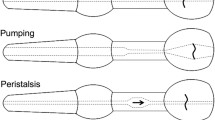Abstract
The pharyngeal pumping motion to send food to the bowel is a rhythmic movement in Caenorhabditis elegans. This paper proposes a simulation-based approach to investigate the mechanisms of rhythm phenomena in the pharyngeal pumping motion. To conduct the simulations, first, we developed a pharyngeal muscle model including 29 cell models which simulate the activity of each cell as a membrane potential based on FitzHugh-Nagumo equations. Then, to compare the response of the model with that of C. elegans, we calculated the electropharyngeogram (EPG), which represents the electrophysiological responses of the pharyngeal cells, using the simulated membrane potentials. The results confirmed that our model could generate the EPG similar to that measured from C. elegans. We proposed a computer simulation of the pumping motion to investigate the mechanisms of rhythm phenomena in living organisms.








Similar content being viewed by others
References
Franks CJ, Holden-Dye L, Bull K, Luedtke S, Walker RJ (2006) Anatomy, physiology and pharmacology of Caenorhabditis elegans pharynx: a model to define gene function in a simple neural system. Invert Neurosci 6:105–122
White JG, Southgate E, Thomson JN, Brenner S (1986) The structure of the nervous system of the nematode Caenorhabditis elegans. Philos Trans R Soc Lond B Biol Sci 314:1–340
Suzuki M, Sakashita T, Hattori Y, Tsuji T, Kobayashi Y (2011) Effects of ionizing radiation on pharyngeal pumping in Caenorhabditis elegans. In: 18th Int. C. elegans Meeting, Full Abstracts, pp 158–159
Avery L, Shtonda BB (2003) Food transport in the C. elegans pharynx. J Exp Biol 206:2441–2457
Raizen DM, Lee YNR, Avery L (1995) Interacting genes required for pharyngeal excitation by motor neuron MC in Caenorhabditis elegans. Genetics 141:1365–1382
Avery L, Horvitz HR (1989) Pharyngeal pumping continues after laser killing of the pharyngeal nervous system of C. elegans. Neuron 3:473–485
Shtonda B, Avery L (2005) CCA-1, EGL-19 and EXP-2 currents shape action potentials in the Caenorhabditis elegans pharynx. J Exp Biol 208:2177–2190
Raizen DM, Avery L (1994) Electrical activity and behavior in the pharynx of Caenorhabditis elegans. Neuron 12:483–495
Kerr R, Lev-Ram V, Baird G, Vincent P, Tsien RY, Schafer WR (2000) Optical imaging of calcium transients in neurons and pharyngeal muscle of C. elegans. Neuron 26:583–594
Starich TA, Lee RYN, Panzarella C, Avery L, Shaw JE (1996) eat-5 and unc-7 represent a multigene family in Caenorhabditis elegans involved in cell–cell coupling. J Cell Biol 134:537–548
Albertson DG, Thomson JN (1976) The pharynx of Caenorhabditis elegans. Philos Trans R Soc B 275:299–325
Fitzhugh R (1961) Impulses and physiological states in theoretical models of nerve membrane. Biophys J 1:445–466
Nagumo J, Arimoto S, Yoshizawa S (1961) An active pulse transmission line simulating nerve axon. Proc IRE 50:2061–2070
Hattori Y, Suzuki M, Soh Z, Kobayashi Y, Tsuji T (2012) Theoretical and evolutionary parameter tuning of neural oscillators with a double-chain structure for generating rhythmic signals. Neural Comp 24:635–675
Acknowledgments
We thank members of the Microbeam Radiation Biology Group at the Japan Atomic Energy Agency for valuable discussions. This study was partially supported by a Grant-in-Aid for Scientific Research on Innovative Areas from MEXT to T.T. (No. 20115010).
Author information
Authors and Affiliations
Corresponding author
About this article
Cite this article
Hattori, Y., Suzuki, M., Soh, Z. et al. Modeling of the pharyngeal muscle in Caenorhabditis elegans based on FitzHugh-Nagumo equations. Artif Life Robotics 17, 173–179 (2012). https://doi.org/10.1007/s10015-012-0064-y
Received:
Accepted:
Published:
Issue Date:
DOI: https://doi.org/10.1007/s10015-012-0064-y




